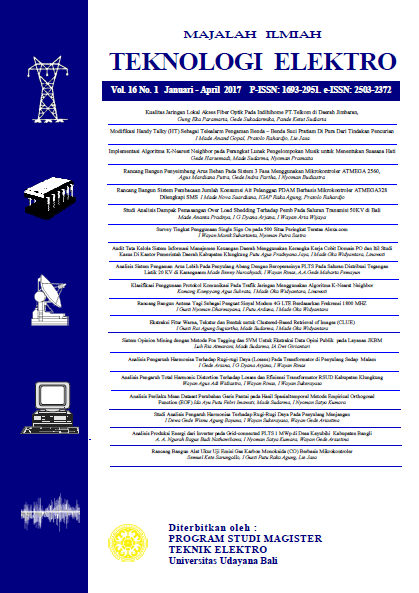Analisis Produksi Energi dari Inverter pada Grid-connected PLTS 1 MWp di Desa Kayubihi Kabupaten Bangli
Abstract
Inverter is a very important component of a grid-connected PV plant related its function to convert photovoltaic DC to be AC power. Inverter constructed from many components to support its operation so that inverter is the most complex component in a PV plant systems. 1 MWp Grid-connected Kayubihi PV Plant uses 50 units 20 kW grid-connected inverter. This research goal is to know how inverter performance also the string array position impact to energy production. Energy production analysis at Kayubihi PV Plant by mapping the energy production percentage each inverter, then choose an inverter with the highest energy production percentage as a reference to measure the other inverters performance. The analysis considers string array location which connected to the inverter too and also based on the condition of PV location. Obtained that the highest energy production is inverter 44-E5 at 17.827 kWh and the lowest is inverter 8-D3 at 8.898 kWh. The highest average energy production is inverter 44-E5 at 72,47 kWh/day, and the lowest is inverter 11-C5 at 39,26 kWh/day. The conclusion is inverter energy production is ? 75 % based on each string array optimum energy with inverter 29-B9 has the highest ? 75 % energy production percentage.
Inverter merupakan komponen yang sangat penting dalam sebuah PLTS yang terhubung dengan jaringan listrik karena fungsinya untuk mengubah daya DC modul surya menjadi daya AC. Inverter dibangun dari berbagai macam komponen untuk menunjang operasinya, sehingga inverter adalah komponen paling kompleks di dalam sistem PLTS. Grid-connected PLTS 1 MWp Kayubihi menggunakan 50 unit inverter dengan kapasitas masing-masing 20 kW. Penelitian ini bertujuan untuk mengetahui bagaimana unjuk kerja inverter serta pengaruh posisi string array terhadap produksi energi. Analisis produksi energi di PLTS Kayubihi dilakukan dengan pemetaan persentase produksi energi dari setiap inverter, kemudian memilih inverter dengan persentase produksi energi tertinggi sebagai acuan untuk menilai unjuk kerja dari 49 inverter yang lain. Analisis juga memperhatikan letak string array yang terhubung dengan inverter serta berdasarkan kondisi lingkungan di lokasi PLTS. Diperoleh bahwa produksi energi tertinggi dihasilkan oleh inverter 44-E5 sebesar 17.827 kWh dan terendah adalah inverter 8-D3 sebesar 8.898 kWh. Inverter dengan produksi energi rata-rata tertinggi adalah inverter 44-E5 sebesar 72,47 kWh/hari dan terendah adalah inverter 11-C5 sebesar 39,26 kWh/hari. Dapat disimpulkan bahwa produksi energi seluruh inverter di PLTS Kayubihi sudah ?75% berdasarkan energi optimum string array masing-masing, dengan inverter 29-B9 memiliki persentase produksi energi ? 75 % tertinggi.
Downloads
References
[2] N. S. Kumara “Pembangkit listrik tenaga surya skala rumah tangga urban dan ketersediaannya di Indonesia”. Majalah Ilmiah Teknologi Elektro. Vol. 9 No. 1. 2010.
[3] L. M. Moore, and H. N. Post. “Five years of operating experience at a large, utility-scale photovoltaic generating plant”. Journal of Prog. Photovoltaic. Volume 16 No. 3: 249-259. 2008.
[4] S. Yang, D. Xiang, A. Briant, P. Mawby, L. Ran and P. Tavner. “Condition monitoring for device reliability in power electronic converters: a review”. IEEE Transactions on Power Electronics. Volume 25: 2734-2752. 2010.
[5] Z. J. Ma and S. Thomas. “Reliability and maintainability in photovoltaic inverter design”. IEEE Reliability and Maintainability Symposium (RAMS). 10.1109/RAMS.2011.5754523. 2011.
[6] K. Chumpolrat, V. Sangsuwan, N. Udomdachanut, S. Kittisontirak, S. Songtrai, P. Chinnavornrungsee, A. Limmanee, J. Sritharathikhun, and K. Sriprapha. “Effect of ambient temperature on performance of grid-connected inverter installed in Thailand”. International Journal of Photoenergy. Vol 2014. 2014.
[7] R. Kaplar, R. Brock, S. DasGupta, M. Marinella, A. Starbuck, A. Fresquez, S. Gonzalez, J. Granata, M. Quintana, M. Smith and S. Atcitty. “PV inverter performance and reliability: What is the role of the IGBT?”. IEEE Photovoltaic Specialists Conference (PVSC) 37th. 1842 - 1847. 2011.
[8] J. D. Flicker, R. Kaplar, M. Marinella, and J. Granata. “PV inverter performance and reliability: What is the role of the bus capacitor?”. IEEE Photovoltaic Specialists Conference (PVSC). Volume 2: 1-3. 2012.
[9] BPS Bangli. Statistik Daerah Kabupaten Bangli 2015. Bangli: BPS Bangli. 2015.
[10] I N. S. Kumara, W.G. Ariastina, I W. Sukerayasa and I. A. D. Giriantari. “1 MWp grid connected PV systems in the Village of Kayubihi Bali; review on location’s characteristics and its technical specifications”. International Conference on Information Technology and Electrical Engineering (ICITEE) 2013. 10.1109/ICITEED.2013.6676258. 2013.
[11] (2011) Florida Solar Energy Center website. [Online] Available: http://www.fsec.ucf.edu/en/consumer/solar_electricity/basics/types_of_pv.htm.
[12] A. Miller and B. Lumby. Utility Scale Solar Power Plants A Guide For Developers and Investors. India: International Finance Corporation (IFC). 2012.
[13] ABB. Technical Application Papers No. 10 Photovoltaic Plants. Bergamo, Italy: ABB SACE. 2010.
[14] I K. A. Setiawan, I N. S. Kumara, and I W. Sukerayasa. “Analisa unjuk kerja pembangkit listrik tenaga surya (PLTS) 1 MWp terinterkoneksi jaringan di Kayubihi Bangli”. Majalah Ilmiah Teknologi Elektro. Vol 13 No. 1. 2014.
[15] Recommended Practice for Utility Interface of Photovoltaic (PV) Systems, IEEE Std. 929-2000.
Keywords

This work is licensed under a Creative Commons Attribution 4.0 International License





